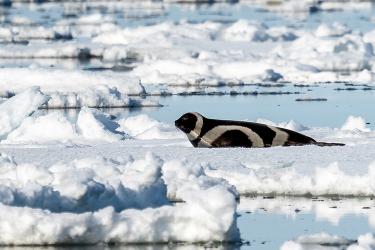Journey to the Ice Seals
The “ice-pushing” R/V Norseman II (Support Vessels of Alaska, Homer, Alaska) set sail from Dutch Harbor on April 15 with a team of scientists determined to better understand the health and ecology of ice seals. It took nearly a week for us to complete our transit to the sea ice near St. Matthew Island, where we have the best chance of locating ribbon and spotted seals.
To avoid being battered by 50 knot winds, freezing rain, and large swells, we hunkered down on the south side of St. George Island before making a run to the sea-ice edge. Sheltering from the storm didn’t stop the boat from rocking however, and I spent most of the week in my bunk, or “lair” as we came to call it, bogged down with seasickness. It all paid off when we reached our destination midday on Friday April 19. The excitement of seeing the ice cured my nausea and brought an air of anticipation to the rest of the team. Our boat was surrounded by large flat white pancakes of ice, and the horizon was no longer a deep rolling blue, but rather a thin white line that met a pale red sunset. The night was cold and mostly quiet despite the occasional thud of a pancake ice floe hitting our hull.
Situated in a large polynya, we used our first full day near the sea ice to deploy our capture boats and complete an initial gear check. A crane on the upper deck of the R/V Norseman II lowered our inflatable boats into the water, and after loading our gear we made our way along the outer edge of the sea ice. Although we saw plenty of ivory gulls, there were no pinnipeds in sight. We instead used this opportunity to practice our capture technique. Seals are deceptively fast on ice, so we need to stay stealthy and swift in order to work with them. We have to crouch low and put our boats in idle until we’re in range for a capture. The boat driver then accelerates quickly and the catcher leaps from the bow onto the ice with a net in hand. We continued practicing until the fog told us it was time to make our return to the R/V Norseman II.
With the sea ice, came the ice seals! On Sunday April 21, we took turns scouting for pinnipeds from the pleasantly warm bridge of the R/V Norseman II and the exposed observation deck known as the “bird box”. When word came from the bridge of a seal shaped object located on the ice just below the horizon, I ran up to the bird box with some other team members to get a better look. We brought out the scope and confirmed our first ribbon seal sighting of the trip! From our binoculars she was a small dark round blip in an endless sea of white and blue, but through the scope we could see the remarkable black and white bands indicative of an adult ribbon seal. Shortly thereafter, a second ribbon seal hauled out right next to the first for a brief interaction, and quickly scanned its surroundings before returning to the water. Temperatures in the bird box were a brisk 20° F with winds exceeding 15 knots, yet we stayed outside to observe her stretch and move about the ice for over half an hour while other team members launched a UAS to get a closer view. Unfortunately, a dense curtain of fog rolled in low and fast which rapidly diminished our ability to scan the ice, so the drone was recalled. With low visibility and winds picking up, our operations for the day ended. Confirmation that we are in the right habitat for ice seals was reassuring, and we’re aiming to get better drone imagery and capture some ice seals in the coming days.









